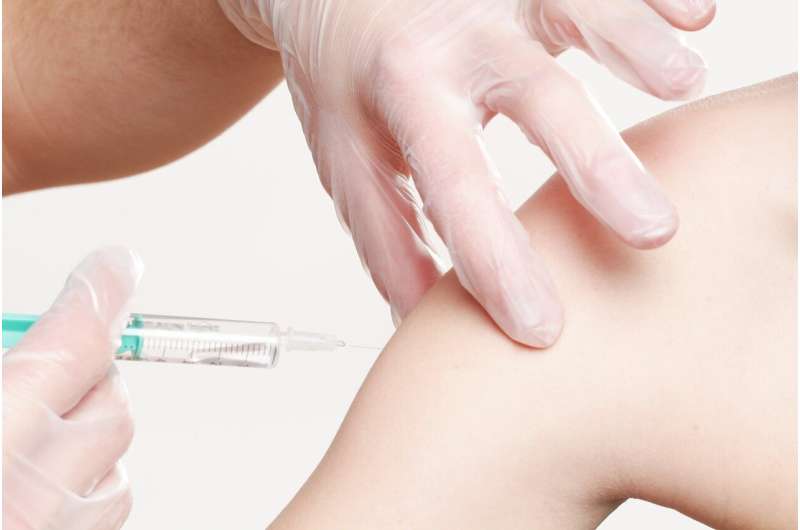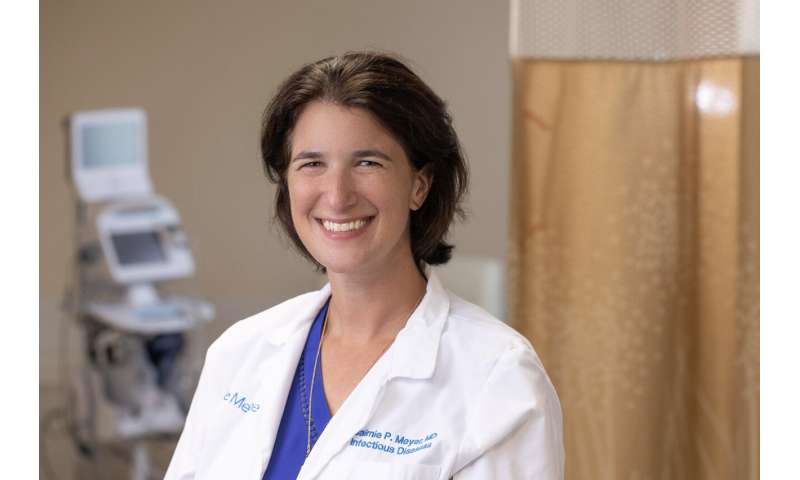
Now that many of us have been fully vaccinated against COVID-19, we are now navigating a new gray area—which of the many rules we’ve been following can we now safely ignore?
Is it really safe to take off your mask and hug your fully vaccinated friend? Are you comfortable with the Centers for Disease Control and Prevention (CDC) guidelines that say it’s OK for your kids (who have not been vaccinated) to visit, inside and unmasked, with their vaccinated grandparents?
After a year of social distancing and shifting public health recommendations, achieving full vaccination can feel like a major milestone—or even a miracle. Many people are beginning to resume pre-pandemic activities they’ve missed dearly, some with an air of triumph, others with a substantial dose of anxiety.
“This is a weird transition. As hard as our abrupt transition was a year ago, this is really hard, too,” says Jaimie Meyer, MD, MS, a Yale Medicine infectious diseases specialist. “You are being asked to let your guard down. I feel it, too. I can’t stop wearing ‘gas gloves,” even though I know contaminated surfaces aren’t the primary way people become infected. We need to learn to get comfortable again with activities that we’ve been avoiding for a year.”
And just because the CDC says it’s now safe to do certain things, that doesn’t mean that you have to, points out Brita Roy, MD, MPH, MHS, a Yale Medicine internist and director of population health.

“Nothing is 100-percent risk free, and you have to do what you feel comfortable with,” Dr. Roy says. “These are individual decisions.”
So, how does one make these decisions? We talked more with Dr. Meyer for some guidance. As always with COVID-19, the answers may not be crystal clear, but there are some general principles to keep in mind that may help.
What COVID-19 precautions have changed?
In early March, the CDC issued guidelines on what activities fully vaccinated Americans could now do. One is considered fully vaccinated two weeks after either the second dose of a two-dose vaccine (Moderna or Pfizer-BioNTech) or a single-dose vaccine (Johnson & Johnson). It takes that long for immunity to fully kick in.
While the fully vaccinated are still advised to take precautions in public places, including wearing a mask, staying 6 feet apart from others, and avoiding crowds and poorly ventilated areas, there were bright spots in the updates.
For example, fully vaccinated people can gather with other fully vaccinated people indoors without wearing a mask. They can also gather indoors, without masks, with unvaccinated people from one other household—but only if none of the unvaccinated people (or those they live with) have an increased risk for severe illness from COVID-19. The CDC provides a full list of conditions that put people at risk for severe illness, which includes cancer, chronic kidney disease, obesity, and chronic lung disease.
According to the CDC, this means that fully vaccinated grandparents can visit with their adult, unvaccinated children and unvaccinated grandchildren indoors without masks—again provided the unvaccinated are healthy and not at risk for severe COVID-19 illness.
How to assess risk
Dr. Meyer welcomes the above guidance from the CDC—especially compared to what things were like a year ago.
“Last year at this time, we were in a huge data vacuum. We were telling people that everything they did required a risk assessment for themselves and anyone they came in contact with, which became very confusing,” Dr. Meyer says. “Now, we understand much more about how the virus is transmitted, and we have safe and effective vaccines at our disposal. This means people who have been vaccinated can take a deep sigh of relief.”
Plus, most public places now have many safety precautions in place, and as more people get vaccinated and case rates eventually go down, our worlds will become even safer, Dr. Meyer says.
There is still a risk assessment, but it’s easier, she adds. “If you are fully vaccinated, there is minimal risk of becoming severely ill with COVID-19,” Dr. Meyer says. While the Pfizer-BioNTech and Moderna vaccines are deemed to be 95% effective, for example, that leaves about 5% of people who may get the virus even though they were vaccinated.
“But are you willing to take the risk of being mildly ill? And what is the risk to whomever you are with, in case you are infected without symptoms but still able to transmit COVID-19 to them?” asks Dr. Meyer. “That has become less of a concern with new data from the CDC, showing that both the Pfizer and Moderna vaccines are highly effective at preventing symptomatic and asymptomatic infection, but there is still a minimal risk to consider.”
Plus, every day we learn more about the virus variants, and those should be a part of your risk calculation, too, she adds. “Some, like the B.1.1.7 variant [which was first identified in the UK], are more contagious and potentially more lethal,” she says. “To date, though, the available vaccines appear to be effective at preventing severe disease even in cases that involve that variant.”
Dr. Meyer did her own risk calculation when it came to seeing her 75-year-old mother. “We are both fully vaccinated and we are able to be together now, hugging and riding together in the car with no masks,” she says. “I am a health care worker, and she sees my kids, but they have no risk factors for severe disease. We had been hedging a little about how to handle this, and then when the CDC came out with more explicit guidance, we decided it was OK to be together, inside, without masks. My mother doesn’t leave the house, so it is unlikely that she could be an asymptomatic carrier and transmit it to my kids.”
When it comes to other friends and family who are not vaccinated and have risk factors, Dr. Meyer maintains the full, usual precautions of masked social distancing.
Continue to be flexible after vaccination
This past year, Dr. Meyer says, has shown us how flexible and adaptable we can be. Maintaining that flexibility may make the next steps easier—and it doesn’t have to be an all-or-nothing approach.
“Unlike when we had to quickly adjust to the extreme of shutting down our lives, now we can slowly slide back into being normal,” she says.
However, a slow transition isn’t what most of us are accustomed to, Dr. Meyer acknowledges.
“We don’t do well in this gray zone. We want a full-out, complete shut down or a full opening up,” she says. “Instead, we are trying to figure this out, and guidance from public health authorities has been intentionally limited because it has to be supported by science. For example, the CDC can’t weigh in yet on every possible scenario, as exact risks just aren’t known yet.”
Enjoy those ‘post-vaccination’ embraces
For Dr. Meyer, full vaccination brought many joys back to her life.
“The first thing I did when I was fully immunized—meaning it had been two weeks since my second vaccination dose—I jumped in my car and drove to Vermont to see my baby nephew and my sister, who I hadn’t seen in a year,” she says. “It was wonderful.”
But she took a number of steps to prepare. Before her trip, Dr. Meyer checked travel restrictions in both Connecticut and Vermont. “I also checked with my employer about what would be required to return to work. I quarantined and tested prior to the trip, and I tested after the trip. And I made sure my test was negative before I returned to work,” she says. “I traveled in my own car and stopped only for gas, which I pumped using my favorite gas glove and Purell! While there I stayed in their home, and I did not go out in public places.”
Her sister, brother-in-law, and nephew were not vaccinated, but none of them have health conditions that would put them at risk of severe disease. The parents both work from home and have been really isolated, she adds.
To be able to do something like see her family—and hug her mother—is very liberating, she adds. “There is a collective trauma from being apart for so long, so to be able to do these things now is great,” she says.
At work, however, Dr. Meyer still wears full personal protective equipment when she takes care of patients, including masks and eye protection. “We still wear masks in the break room, but there is peace of mind that comes with being vaccinated myself, as well as knowing that my coworkers are almost all vaccinated, and that many of our patients are vaccinated, too. That makes me much less worried about becoming ill or bringing the virus home to my family.”
For those who don’t work in health care settings and do not have the option of working remotely, there may be a variable amount of protection in the workplace, Dr. Meyer acknowledges.
“So, the best thing you can do is to protect yourself with vaccination. Continue to wear masks and practice social distancing as much as you can, especially if your coworkers are not yet vaccinated,” she says.
It’s OK to want zero risk
When it comes to making choices and assessing various risks, it’s also perfectly fine to go the most cautious route, if you can, Dr. Meyer says.
“If your level of comfort with risk really is zero, then you should continue doing exactly what you’ve hopefully been doing—sticking to outdoor visits and masks and distancing,” she says. “I’m really happy that we live in a place like Connecticut where anyone over the age of 16 is now eligible to be vaccinated, and most adults may be vaccinated by summer. That is the push right now for vaccination—getting us to a new normal.”
Source: Read Full Article
